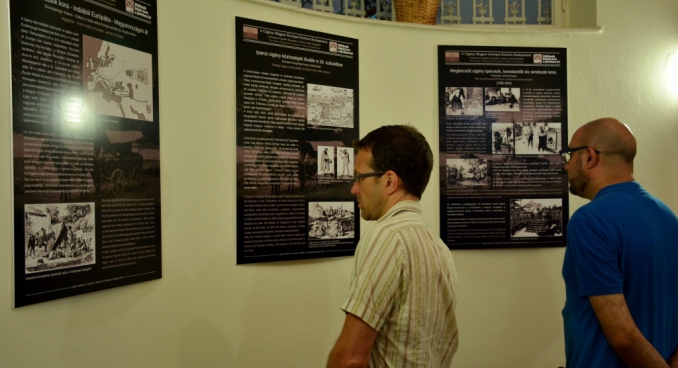The Roma Genocide in Context
On the occasion of the Commemoration Day of the Roma Holocaust, the Tom Lantos Institute would like to draw the attention to the exhibition, which gives an overview of the European and Hungarian history of the Roma, from India to the present day, with special emphasis on the Roma Holocaust. The exhibition can be visited in the building of the Institute of Foreign Affairs and Trade and the Tom Lantos Institute, until 31 September 2015.
The exhibition was curated by historians Ferenc Kardos and József Tulok on request of the Roma Civic Association (Roma Polgári Tömörülés). The organisation was offered a building in Csepel by a couple in 2012, which is now the Roma History, Culture, Education and Holocaust Centre. An integral part of the museum presenting the history, material and nonmaterial culture of the Roma in Hungary is an exhibition consisting of 12 panels, which show the way leading to the Roma Holocaust, as well as the steps taken after World War II to face this tragedy, making this exhibition unique in Hungary.
According to the historians who created the exhibition, as well as the leaders of the Centre, the path of reconciliation and of the emancipation of Roma is through self-knowledge and the strengthening of identity, for which getting to know Roma culture and history is a prerequisite. Pharrajimos is an essential part of this history.
The Tom Lantos Institute agrees with this approach, and as it is committed to spreading knowledge about the Roma Genocide, it has made mobile panels of this exhibition in order to enable them to reach a wider audience. The first station of the mobile exhibition is the building shared by the Institute of Foreign Affairs and Trade and the Tom Lantos Institute, and the next stations will be decided on by the Roma Civic Association; the Centre for Roma History, Culture, Education, and Holocaust; and the interest of the audience, as after September 2015 the TLI confers the panels to the above organisations.
The Tom Lantos Institute considers research in the field of the Roma Genocide highly important, including the acknowledgement of the responsibility of the Hungarian State and society. As the TLI wishes to contribute to spreading information about this topic, many of the Institute’s current and planned projects focus on this issue.
The exhibition consists of 12 panels, three out of which can be regarded as a historical introduction to the following seven panels directly or indirectly dealing with the Holocaust. These first panels summarise the journey from India to Hungary with special attention to the period of Turkish occupation, as well as the traditional Roma occupations, which were historically acknowledged and were important for society. The last two panels present famous Roma artists from the history of Hungary.
From the six panels dealing with the Pharrajimos, the first one shows the stages of the persecution of the Roma through seven memorable dates, from the establishment of the fascist regime to 2 August 1944, the elimination of the “Gypsy camp” in Auschwitz, when in the course of a single night approximately 3000 Roma women, men and children became victims of the ideology. The second panel lists the political regulations and its consequences from 1913 to 1939, which denied the Roma their rights of practicing their traditional trades; their rights to settling down and working; their rights to marry non-Roma; and made deportations possible. The third panel shows the different deaths awaiting the Roma, from starvation to being shot into the grave dug by oneself. The next panel bears the title, The Chronology of the Pharrajimos, and the fifth one lists the different stages of the deportation of Roma from Budapest. The last two panels connect the first steps of self-mobilisation of the European and Hungarian Roma communities to the stages of facing the events of World War II.
The exhibition can be visited at the the Roma History, Culture, Education and Holocaust Centre all year round (1212 Budapest, Szent István út 71., Roma Civic Association, tel: +36 1 789 0517; email: [email protected], please make an appointment); or, until the end of September 2015, it can be viewed in the building of the Institute of Foreign Affairs and Trade and the Tom Lantos Institute (1016 Budapest, Bérc utca 13-15.), from Monday to Thursday 8 am to 4 pm, and on Friday 8 am to 2 pm. (If you wish to visit the exhibition outside these hours, please make an appointment on this number: +36 1 279 5700. Thank you!)




